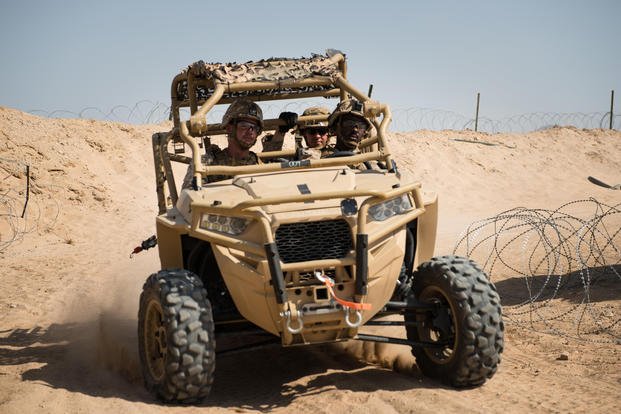Marine special operators are still using the militarized version of a lightweight off-roading vehicle that has reportedly caught fire more than 180 times, killing four people and injuring 30.
Marine Corps Forces Special Operations Command has not received any manufacturing recalls on the more than 50 Polaris MRZR vehicles Marine Raiders began using in 2014, said Gunnery Sgt. Lynn Kinney, a command spokeswoman.
The New York Times reported last week on the 10 recalls Polaris Industries had issued for fire hazards on its RZR vehicles between 2013 and 2018. There are dozens of social media posts showing the vehicles burning, the paper reported, and the accidents have led to a host of lawsuits, including wrongful death and personal injury claims.
Kinney said MARSOC takes the safety and security of Raiders seriously at all times.
Related: MARSOC Identifies Marine Killed in MRZR Vehicle Accident
The command is still using its MRZRs for training and overseas missions, she said, along with some commercial Polaris vehicles MARSOC has in its inventory. They haven't had problems with any of the vehicles, she added.
Polaris company officials said that, while branding between the MRZR and RZR versions are similar, the Marine Corps models are “designed in cooperation with our partners to meet the needs of the government and military customers.”
“We are not aware of fires involving the MRZR,” they added.
The company also hit back against the recent article by The New York Times, saying the allegations, inferences are, they believe, “misleading, lack full context and, at times, are simply inaccurate.”
“Polaris employees, from our senior leaders to our assembly workers on the line, put our riders at the center of our vehicle designs,” the company said in a statement. “With them in mind, we take measures to comprehensively and proactively address safety and quality across the board, which includes vehicle design and assembly, a methodical review of warranty claims, and customer issues for vehicles that have left our control. We have invested, and continue to invest, heavily in safety.”
The gas- and diesel-powered vehicles come in four models that can carry between 1,000 and 1,500 pounds. The unarmored vehicles can fit either four or six people, depending on the model, and can fit into an MV-22B Osprey aircraft.
The Marine Corps buys only the diesel-powered models, Polaris officials said.
MARSOC had its first MRZR death earlier this year when Staff Sgt. Joshua Braica was killed in a rollover accident. Two others were injured in the crash, which remains under investigation.
There were no reports of fire being involved in that mishap.
Kinney said MARSOC has extensive training and licensing requirements to "ensure maintainers and operators follow the provided technical manual, which include manufacturer warnings regarding safe vehicle operation."
"The operator's manual has fire safety warnings for exhaust systems and refueling operations, and each vehicle is equipped with a fire extinguisher," she added.
Marines recently used a weapon system that includes an MRZR to take out an Iranian drone from aboard the amphibious assault ship Boxer, as first reported by Military.com. Marines attach an anti-drone system called LMADIS -- or the Light Marine Air Defense Integrated System -- to tactical vehicles, including the MRZR, to scan the skies for enemy aircraft.
The system has been used on ships' flight decks and on land.
Editor's Note: This story has been updated with comments from the manufacturer.
-- Gina Harkins can be reached at gina.harkins@military.com. Follow her on Twitter @ginaaharkins.
Related: Here's the New Marine Corps Weapon that Just Destroyed an Iranian Dron














